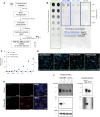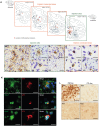Tau seeds from patients induce progressive supranuclear palsy pathology and symptoms in primates
- PMID: 36382344
- PMCID: PMC10232263
- DOI: 10.1093/brain/awac428
Tau seeds from patients induce progressive supranuclear palsy pathology and symptoms in primates
Abstract
Progressive supranuclear palsy is a primary tauopathy affecting both neurons and glia and is responsible for both motor and cognitive symptoms. Recently, it has been suggested that progressive supranuclear palsy tauopathy may spread in the brain from cell to cell in a 'prion-like' manner. However, direct experimental evidence of this phenomenon, and its consequences on brain functions, is still lacking in primates. In this study, we first derived sarkosyl-insoluble tau fractions from post-mortem brains of patients with progressive supranuclear palsy. We also isolated the same fraction from age-matched control brains. Compared to control extracts, the in vitro characterization of progressive supranuclear palsy-tau fractions demonstrated a high seeding activity in P301S-tau expressing cells, displaying after incubation abnormally phosphorylated (AT8- and AT100-positivity), misfolded, filamentous (pentameric formyl thiophene acetic acid positive) and sarkosyl-insoluble tau. We bilaterally injected two male rhesus macaques in the supranigral area with this fraction of progressive supranuclear palsy-tau proteopathic seeds, and two other macaques with the control fraction. The quantitative analysis of kinematic features revealed that progressive supranuclear palsy-tau injected macaques exhibited symptoms suggestive of parkinsonism as early as 6 months after injection, remaining present until euthanasia at 18 months. An object retrieval task showed the progressive appearance of a significant dysexecutive syndrome in progressive supranuclear palsy-tau injected macaques compared to controls. We found AT8-positive staining and 4R-tau inclusions only in progressive supranuclear palsy-tau injected macaques. Characteristic pathological hallmarks of progressive supranuclear palsy, including globose and neurofibrillary tangles, tufted astrocytes and coiled bodies, were found close to the injection sites but also in connected brain regions that are known to be affected in progressive supranuclear palsy (striatum, pallidum, thalamus). Interestingly, while glial AT8-positive lesions were the most frequent near the injection site, we found mainly neuronal inclusions in the remote brain area, consistent with a neuronal transsynaptic spreading of the disease. Our results demonstrate that progressive supranuclear palsy patient-derived tau aggregates can induce motor and behavioural impairments in non-human primates related to the prion-like seeding and spreading of typical pathological progressive supranuclear palsy lesions. This pilot study paves the way for supporting progressive supranuclear palsy-tau injected macaque as a relevant animal model to accelerate drug development targeting this rare and fatal neurodegenerative disease.
Keywords: non-human primate; parkinsonism; prion-like; progressive supranuclear palsy; tau; tauopathy.
© The Author(s) 2022. Published by Oxford University Press on behalf of the Guarantors of Brain. All rights reserved. For permissions, please e-mail: journals.permissions@oup.com.
Conflict of interest statement
E.B. is a director and shareholder of Motac Neuroscience Ltd. G.C. is a shareholder of ONWARD Medical, a company without direct relationships with the presented work. The other authors report no competing interests.
Figures





Comment in
-
The MonKEY to Unlocking the Pathogenesis of Progressive Supranuclear Palsy.Mov Disord. 2023 Jun;38(6):953-954. doi: 10.1002/mds.29404. Epub 2023 Apr 12. Mov Disord. 2023. PMID: 37050873 No abstract available.
References
-
- Rösler TW, Tayaranian Marvian A, Brendel M, et al. . Four-repeat tauopathies. Prog Neurobiol. 2019;180:101644. - PubMed
Publication types
MeSH terms
Substances
Grants and funding
LinkOut - more resources
Full Text Sources
Medical

